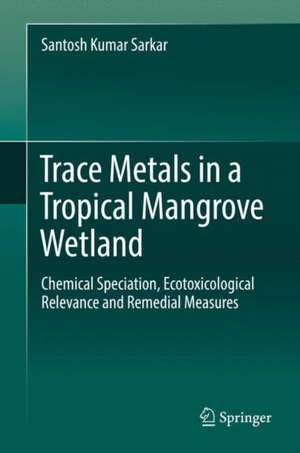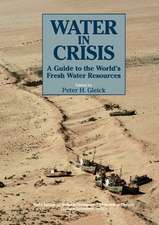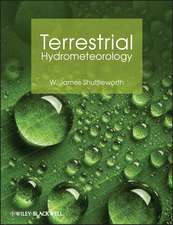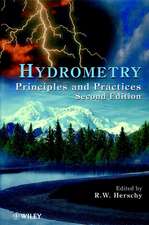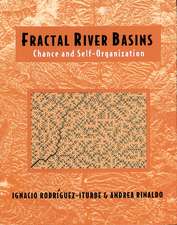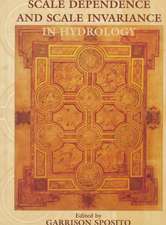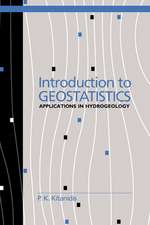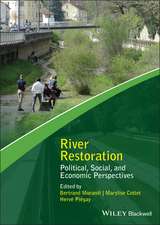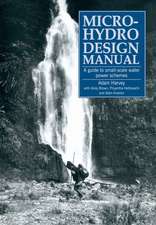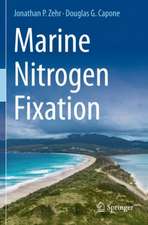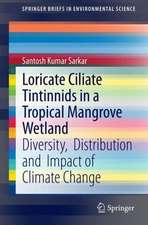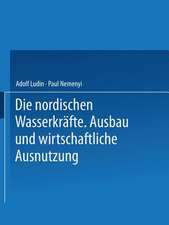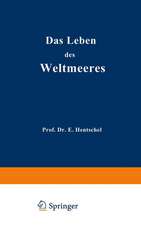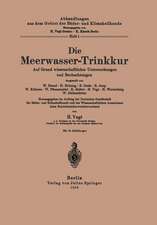Trace Metals in a Tropical Mangrove Wetland: Chemical Speciation, Ecotoxicological Relevance and Remedial Measures
Autor Santosh Kumar Sarkaren Limba Engleză Hardback – 29 aug 2017
| Toate formatele și edițiile | Preț | Express |
|---|---|---|
| Paperback (1) | 556.78 lei 38-45 zile | |
| Springer Nature Singapore – 12 aug 2018 | 556.78 lei 38-45 zile | |
| Hardback (1) | 895.76 lei 3-5 săpt. | |
| Springer Nature Singapore – 29 aug 2017 | 895.76 lei 3-5 săpt. |
Preț: 895.76 lei
Preț vechi: 1092.39 lei
-18% Nou
Puncte Express: 1344
Preț estimativ în valută:
171.41€ • 183.29$ • 142.91£
171.41€ • 183.29$ • 142.91£
Carte disponibilă
Livrare economică 28 martie-11 aprilie
Preluare comenzi: 021 569.72.76
Specificații
ISBN-13: 9789811027925
ISBN-10: 9811027927
Pagini: 262
Ilustrații: XIX, 247 p. 37 illus., 26 illus. in color.
Dimensiuni: 155 x 235 mm
Greutate: 0.58 kg
Ediția:1st ed. 2018
Editura: Springer Nature Singapore
Colecția Springer
Locul publicării:Singapore, Singapore
ISBN-10: 9811027927
Pagini: 262
Ilustrații: XIX, 247 p. 37 illus., 26 illus. in color.
Dimensiuni: 155 x 235 mm
Greutate: 0.58 kg
Ediția:1st ed. 2018
Editura: Springer Nature Singapore
Colecția Springer
Locul publicării:Singapore, Singapore
Cuprins
1. Introduction.- 2. Materials and Methods.- 3. Trace Element Contamination in Surface Sediment of Sundarban Wetland.- 4. Total and Acid-leachable Trace Metals in Surface Sediments along Hooghly (Gangels) River Estuary, India.- 5. Bioaccumulation of Trace Metals in Macrozoobenthos of Sundarban Wetland.- 6. Geochemical Speciation and Risk Assessment of Trace Metals in Sediments of Sundarban Wetland.- 7. Organotin Compounds in Surficial Sediments of Sundarban Wetland and Adjacent Coastal Regions.- 8. Arsenic Speciation in Sediments and Representative Biota of Sundarban Wetland.- 9. Phytoremediation of Trace Metals by Mangrove Plants in Sundarban Wetland.
Notă biografică
Dr. Santosh Kumar Sarkar, Professor of Marine Science, University of Calcutta, has over 30 years of research experience in marine and estuarine ecology, biology and geochemistry. He has authored more than 70 peer-reviewed scientific articles and several book chapters and also edited a book. He has been the Principal Investigator for 12 national projects in India and 7 international collaborative research projects. He has engaged in collaborative research work with renowned research institutes around the globe, namely, the Institute Rudjer Boskovic, Croatia; University of Genoa and University of Milan, Italy ; IPIMAR/INRB IP, Portugal ; University of Edinburgh, British Geological Survey, UK; University of Wuppertal, Germany; CSIRO, Adelaide, Australia; Masaryk University, Czech Republic and Fluminense Federal University,Brazil. He published the book “Loricate Ciliate Tintinnids in a Tropical Mangrove Wetland: Diversity, Distribution and Impact of ClimateChange” with Springer in 2014, as well as another book titled “Marine Organic Micropollutants: A Case Study of the Indian Sundarban Mangrove Wetland” with Springer (forthcoming).
Textul de pe ultima copertă
This book offers a comprehensive and accessible guide covering various aspects of trace metal contamination in abiotic and biotic matrices of an iconic Indian tropical mangrove wetland – Sundarban. Divided into nine chapters, the book begins by discussing the fundamental concepts of sources, accumulation rate and significance of trace metal speciation, along with the impact of multiple stressors on trace metal accumulation, taking into account both tourist activities and the exacerbating role of climate change. The second chapter presents a detailed account of the sampling strategy and preservation of research samples, followed by exhaustive information on sediment quality assessment and ecological risk, instrumental techniques in environmental chemical analyses, quality assurance and quality control, along with the Sediment Quality Guidelines (SQGs). Using raw data, the sediment quality assessment indices (e.g., pollution load index, index of geoaccumulation, Nemerow Pollution LoadIndex etc.) and conventional statistical analyses are worked out and interpreted precisely, allowing students to readily evaluate and interpret them. This is followed by chapters devoted to trace metal accumulation in sediments and benthic organisms, as well as acid-leachable and geochemical fractionation of trace metals in sediments. The book then focuses on chemical speciation of butylin and arsenic in sediments as well as macrozoobenthos (polychaetous annelids). Finally, potential positive role of the dominant mangrove Avicennia in sequestering trace metals from rhizosediments of Sundarban Wetland is elaborately discussed. This timely reference book provides a versatile and in-depth account for understanding the emerging problems of trace metal contamination – issues that are relevant for many countries around the globe.
Caracteristici
Highlights trace metal contamination levels, bioavailability and toxicity in sediments and biota of Sundarban, an iconic tropical mangrove wetland Quantifies chemical speciation of trace metals to predict their mobility and potential toxicity Explores the possibility of reducing toxicity of trace metals by means of mangrove plants by phytoremediation technology
